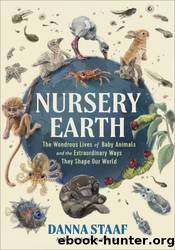Nursery Earth by Danna Staaf

Author:Danna Staaf [Staaf, Danna]
Language: eng
Format: epub
ISBN: 9781615199334
Published: 2023-06-15T00:00:00+00:00
11. Caterpillars, often thought to be little more than eating machines, demonstrate a surprising array of social behaviors.
Insects typically live most of their lives as larvae, and in some cases, they wonât even eat as adults, so their entire lifeâs nutrition depends on their childhood diet. Larvae take this charge seriously. Aquatic insect larvae can grow big enough to eat fish. Antlion larvae are so ferocious that the species is named for their habit of digging traps to catch and suck the juices out of other insects, especially ants. The adults, by contrast, are short-lived and forgettable. Even social insect larvae that spend all their time coddled inside a nest can provide for adults of the species. Some colonial wasps bring meals of meat to their larvae, who then produce a nectar-like saliva to sustain the adultsâa fascinating reversal of our human tendency to prefer easily digested sugars in youth and more savory protein sources as we grow.22
Monarch butterflies and their relatives, meanwhile, depend on larvae not for nutrition but for protection. These butterflies are famously bad-tasting to predators, and the reason theyâre so nauseating is that as caterpillars they store up toxins from a diet of poisonous milkweed. Adults canât replenish this supply, as they feed on flower nectar instead. It was thought for a long time that each adult accumulated plenty of toxins during its own youth, but research in 2021 revealed that the adults of some species will attack caterpillars and suck their blood to supplement their own defensive store. (This behavior hasnât yet been observed in the iconic monarch itself, only in some of its close cousins.23)
In the ocean, larval diet and adult diet tend to be more decoupled. Insect larvae are often larger or heavier than adults by the time of metamorphosis, then lose weight so they can fly. By contrast, marine invertebrate larvae are typically far smaller than adults all the way through metamorphosis. As weâve seen, this is one reason these larvae often concentrate on collecting algal cells for dinner, while adults may be preying on whole animals.
Crown-of-thorns starfish, for example, are infamous for huge outbreaks of coral-eating adults that can destroy entire reefs. But crown-of-thorns larvae are tiny herbivores, collecting and eating algae and bacteria and even quietly absorbing nutrients dissolved in the water around them. Though this habit seems innocuous, it may actually contribute to outbreaks of adults. When agricultural runoff floods coastal waters with excess nutrients, crown-of-thorns larvae could grow and thrive and eventually settle in immense numbers.
Research on larval crown-of-thorns also offers encouraging possibilities for population control. These larvae contain toxins that were once thought to deter predators, because when scientists extracted the toxins and put them into fish food pellets, fish preferred to eat pellets without toxins. However, scientists were recently able to create a more ecologically relevant scenario, offering a variety of live starfish larvae to predatory fish. They found that many species of fish would readily consume large quantities of crown-of-thorns larvae.24 Apparently, the toxins are insufficient deterrents when an entire delicious larva is on the menu.
Download
This site does not store any files on its server. We only index and link to content provided by other sites. Please contact the content providers to delete copyright contents if any and email us, we'll remove relevant links or contents immediately.
Sapiens: A Brief History of Humankind by Yuval Noah Harari(14254)
The Tidewater Tales by John Barth(12609)
Mastermind: How to Think Like Sherlock Holmes by Maria Konnikova(7228)
Do No Harm Stories of Life, Death and Brain Surgery by Henry Marsh(6891)
The Thirst by Nesbo Jo(6829)
Why We Sleep: Unlocking the Power of Sleep and Dreams by Matthew Walker(6618)
Life 3.0: Being Human in the Age of Artificial Intelligence by Tegmark Max(5475)
Sapiens by Yuval Noah Harari(5294)
The Longevity Diet by Valter Longo(5021)
The Body: A Guide for Occupants by Bill Bryson(4975)
The Rules Do Not Apply by Ariel Levy(4863)
The Immortal Life of Henrietta Lacks by Rebecca Skloot(4526)
Animal Frequency by Melissa Alvarez(4395)
Why We Sleep by Matthew Walker(4361)
The Hacking of the American Mind by Robert H. Lustig(4319)
Yoga Anatomy by Kaminoff Leslie(4306)
All Creatures Great and Small by James Herriot(4233)
Double Down (Diary of a Wimpy Kid Book 11) by Jeff Kinney(4208)
Barron's AP Biology by Goldberg M.S. Deborah T(4100)
